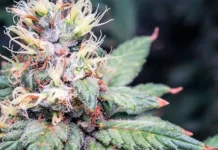Cannabis may also share the medical properties of garlic
Some cannabis strains have a distinctly tangy flavor that somewhat resembles garlic– and now scientists have found out why. After performing a comprehensive gas chromatography analysis of cannabis flowers, a team of scientists found that the “skunk-like” scent of certain strains can be narrowed down to specific volatile sulfur compounds. These chemicals are very similar to those found in garlic (allium sativum), which “suggests an opportunity to also investigate their potential health benefits,” the authors wrote in their study.
Cannabis has one of the most complex odors in the botanical world, with over 200 distinct aroma compounds previously reported thus far. Most of these volatile compounds belong to the terpenoid class (terpenes) and each strain has a dominant type of terpene that is responsible for their characteristic aroma. For instance, pinene is responsible for some strains’ pine-like fragrance, while caryophyllene is peppery.
Terpenes play a major role in the cannabis plant — and it’s not just the flavor and odor. Research suggests that cannabis terpenes play a considerable role in not only tempering the intoxicating effects of THC, but also creating synergy with phytocannabinoids and even increasing their therapeutic value. Researchers at the Israel Institute of Technology are even investigating marijuana terpenes as an anti-inflammatory agent to prevent the most severe, life-threatening cases of COVID-19.
Concerning the “skunk-like” odor of marijuana, some have suggested that it is owed to myrcene, an earthy or musky terpene. While a skunk’s defensive spray doesn’t contain terpenes, it has similar compounds called thiols. When these organic sulfurs mix together, they produce the potent, musky scent that people stay away from — unless it’s marijuana.
While terpenes may indeed contribute to the skunk-like odor of marijuana, a new study published in ACS Omega identified a new family of volatile sulfur compounds (VSCs) containing the prenyl (3-methylbut-2-en-1-yl) functional group that is responsible for this scent. The concentrations of the discovered VSCs increase significantly toward the end of the flowering stage of growth, reach a maximum during curing, and then drop substantially after only 10 days of storage, the researchers found after performing an indoor greenhouse trial.














